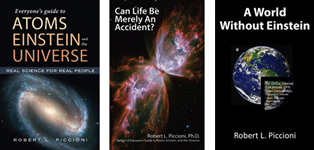The most spectacular and violent cosmic fireworks that astronomers can foresee will be happening right here on July 4th, in the year 3900001776..(just kidding on the date)
Our galaxy, the Milky Way, is the second
largest of the 50+ galaxies in a cluster called the Local Group, which
spans 10 million light-years (60 million trillion miles).
Andromeda is our big sister— the largest
galaxy in the Local Group. Andromeda and the Milky Way dominate the
cluster, with all the other galaxies being much smaller. Each of these
two great galaxies has over a dozen satellite galaxies orbiting around
them. Andromeda and the Milky Way have kept their distance from each
other for billions of years—at least so far.
Apparently, it’s time for an intimate family gathering of colossal proportions.
Recent Hubble Space Telescope
observations reveal that Andromeda will hit our galaxy head on…in 3.9
billion years. You may want to reconsider your long-term investment
strategy.
Galactic collisions are common in our
universe. That’s how the biggest galaxies grew so large. We’ve observed
many distant galaxies in various stages of colliding, and we have seen
what results.
Andromeda is now 2.5 million light-years
(15 million trillion miles) away and is moving toward the Milky Way at
246,000 mph. On Earth, we see Andromeda approaching at 677,000 mph, but
that’s because our Solar System orbits the Milky Way at 500,000 mph and
is now moving more or less toward Andromeda. About 110 million years
from now, the Solar System will be on the opposite side of its orbit and
Earth will be moving away from Andromeda. Our changing perspective
clearly doesn’t change the galaxies’ motion.
As the two great galaxies come closer,
their mutual gravitational attraction will increase and their closing
velocity will accelerate. The Milky Way’s 300 to 400 billion stars will
be flung at Andromeda’s trillion stars at 1.3 million mph. Just imagine
how exciting that might be.
In the galactic suburbs, there’s
typically a vast distance between individual stars—galaxies are mostly
empty space. If the collision occurs in the spiral arms, it’s likely
there will be a lot of gravitational pushing and shoving but no
star-on-star collisions. However, the latest estimate says it’s 41%
likely that the galaxy centers will collide head on, which would be much
more dramatic.
After the initial impact, astronomers
predict the two galaxies will pass through one another, move apart, and
reach a maximum separation of 560,000 light-years, 4.8 billion years
from now. They will then start falling directly toward one another for a
final climatic merger 6.3 billion years from now. The resulting system,
dubbed Milkomeda, will be an immense elliptical galaxy, devoid of
spiral arms.
The benign, nearly circular orbits now
enjoyed by stars in both galaxies will be severely disrupted and may
become chaotic. Billions of stars will be flung into supermassive black
holes and billions more will be flung outward by “tidal” forces. Tidal
tails may span over 5 times the Milky Way’s current size. The latest
measurements are still not precise enough to determine where our Solar
System will be during the collision, but it unlikely that our Sun will
be separated from its planets.
Two majestic spiral galaxies will exist
no more, replaced by a vast elliptical blob. The neighborhood will never
be the same again.
I’m often asked: How can Andromeda be
coming toward us when the universe is expanding and everything is
supposed to be moving away from us? The answer is that things move due
to a variety of factors, which can be complicated.
After teaching at UCLA, I drive home at
15 mph on the 405 Freeway. But I’m also moving east at 800 mph due to
Earth’s rotation, and moving 70,000 mph due to Earth orbiting the Sun,
and 500,000 mph as the Sun orbits the Milky Way, and…
The universe is expanding at 50,000 mph
per million light-years—the Hubble expansion rate. This means a distance
that is 1 million light-years today is expanding 50,000 miles per hour,
and a distance that is 10 million light-years is expanding 500,000
miles per hour.
Andromeda is now 2.5 million light-years
away, so the distance between us is expanding at a rate of 125,000 mph.
But at the same time, Andromeda and the Milky Way are falling toward
one another at 371,000 mph because of their mutual gravitational
attraction. The net motion is the galaxies are approaching at
246,000 mph.
If Andromeda were 10 times farther, 25
million light-years, the space between us would be expanding at
1,250,000 mph. At that distance, the gravitational force would be 100
times less, too weak to overcome the expansion. As the numbers work out,
galactic motions within clusters are dominated by mutual gravity, while
the clusters themselves are moving apart with universal expansion.
Below is NASA’s concept of what this collision will look like from Earth.

Starting in the upper left, the broad
band of the Milky Way is seen cutting across our sky at a slight
diagonal, with Andromeda being the modest oblong object left of the
Milky Way.
In the upper right image and then the second-highest image on the left, we see Andromeda approaching and growing larger.
The fourth and fifth images show the
first collision, with the sixth showing the galaxies' maximum separation
before the final merger in the last image.

Have a safe and wonderful 4th of July!
-------------------------------------------------------------------------------------------------------------------

Dr. Robert Piccioni
www.guidetothecosmos.com
Author of "Everyone's Guide to Atoms, Einstein, and the Universe",
"Can Life Be Merely An Accident?"
& "A World Without Einstein"

|